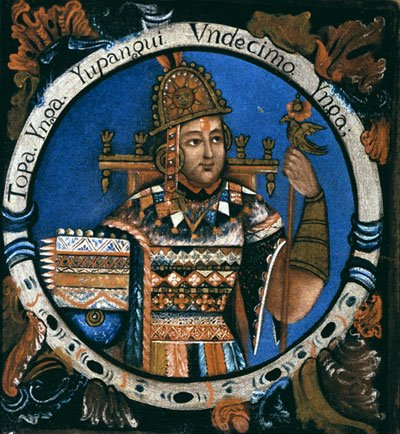Incan Painting of the Colonial Period: School of Cuzco
Last Saturday night, I started a new landscape painting by doing a sketch in linseed oil-thinned oil paint. You’ve read about my art historian geekhood on this blog, but now you’ll hear about the artist-geek half which is me. The morning after I start a painting I absolutely love the smell in my living room/studio of linseed oil and turpentine. I’d have to say that excitement goes all the way back to fourth grade when my daddy (who was an artist and engineer) bought me my first oil paints and taught me how to use them.
This all got me wondering about other artists first exposed to the medium. Many non-Western cultures had no experience with oil paint yet developed wonderful traditions in the medium. Continuing my fascination with Mesoamerican art from last week, I started thinking about the Peruvian school of painting shortly after Spanish conquest. Were the native Incans who were trained by Spanish Baroque artists as thrilled with oil painting as I was in fourth grade? Could they have been mesmerized by the medium as I was? (I know, I’m a geek!)
 |
| School of Cuzco, Peru, Tupac Yupanqui, Eleventh Inca, from the series Fourteen Portraits of Inca Kings, mid-1700s. Oil on canvas, (58.7 x 54 cm). © Brooklyn Museum, Brooklyn, NY. (BMA-152) |
The Inca were a small highland culture who established their rule in the valley of Cuzco, Peru, around 1100 CE. The city of Cuzco was their capital, and by 1350, they had extended their rule to all of the areas close to Lake Titicaca in the south as well as the valleys immediately east of Cuzco. They also controlled northward to the upper Urumbamba River. By 1450, their empire stretched from Quito in present-day Ecuador to central Chile, a territory of 3,000 miles.
Cuzco was always a center of artistic production during the Inca empire. After the Spanish conquest (c1531–1532), Spanish artists who arrived in the Viceroyalty of Peru taught their techniques to native artists. Within 50 years of the conquest, native artists had mastered European styles, techniques, and compositions and were producing portraits, religious, and narrative works.
The Inca before the conquest had no portrait painting comparable to the European tradition. They appropriated it to portray their ancestors and honor their independent past. Throughout the colonial period, portraits of Inca rulers in the European style were prized by colonial aboriginal nobility as evidence of their aristocratic forebearers.
This portrait of Tupac Yupanqui is probably based on a series of works executed in the 1570s as a gift to King Phillip II of Spain. The series was reissued in oil between 1726 and 1730. Tupac Yupanqui ruled the Inca between 1471 and 1493, and was the son of Pachacutec. He led the conquest of the Chimú Empire in 1470, and doubled the size of the Inca Empire. While the portrait bears all the hallmarks of the Spanish Baroque style, the native artist was careful to include all of the symbols of ritual regalia that marked the Inca rulers.
After a series of rebellions by Peruvian natives in the late 1700s, the confidence of the Spanish invaders was shaken. Inca portraits such as this were forbidden and many destroyed. Some series were hidden, and this portrait may come from one of those. When Peru gained independence from Spain in the 1821, the Inca portraits again enjoyed popularity, especially among travelers to Peru, another way the portraits left the country.


Comments